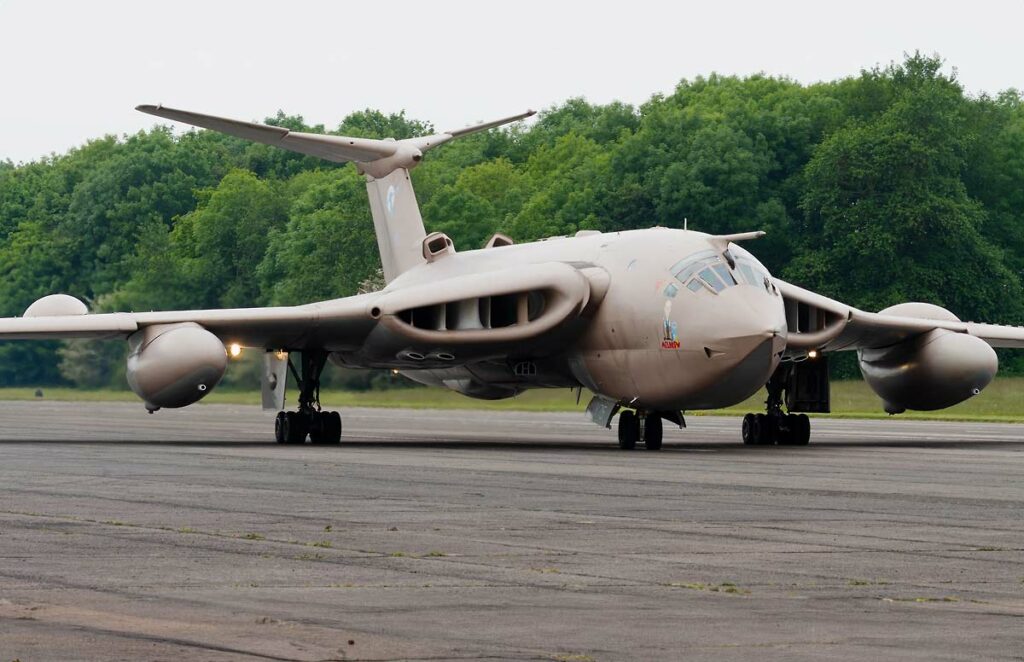The Handley Page Victor, a British jet-powered strategic bomber, part of the V-bomber trio, known for its crescent wing design and nuclear deterrence role.
This article explores the Handley Page Victor, a key player in Britain’s Cold War aerial strategy. It details the aircraft’s development, highlighting the historical context and strategic needs it was designed to meet. The design section elaborates on its unique features, advantages, and challenges. The performance analysis compares the Victor to its contemporaries, emphasizing its strengths in speed, altitude, and range. The military use and combat section outlines its armament, operational history, and legacy, including its role in conflicts and subsequent retirement.
The Handley Page Victor stands as a significant figure in the annals of military aviation, particularly during the Cold War era. It was one of the three main V-bombers used by the Royal Air Force (RAF) for nuclear deterrence.
History of the Development of the Handley Page Victor:
The development of the Handley Page Victor was a direct response to the geopolitical tensions of the Cold War. Britain, seeking to maintain a credible nuclear deterrent against the Soviet Union, initiated the V-bomber program. The Victor, developed alongside the Avro Vulcan and Vickers Valiant, was a part of this strategic initiative.
The Handley Page Aircraft Company was responsible for the Victor’s development. The program officially commenced in the late 1940s, with a specific focus on creating a high-altitude, high-speed bomber capable of eluding early radar detection and interception.
The Victor took its first flight on December 24, 1952. It didn’t receive a specific NATO nickname, as it was primarily operated by the RAF and not widely exported or integrated into broader NATO operations.
Design of the Handley Page Victor:
The design of the Victor was revolutionary for its time. Its most distinguishing feature was its crescent-shaped wings, which had a span of 35 meters (114 feet 10 inches) and were designed to optimize high-speed, high-altitude performance. The aircraft had a length of 34.8 meters (114 feet 2 inches) and a height of 8.6 meters (28 feet 2 inches).
The Victor’s airframe was designed for aerodynamic efficiency and radar cross-section reduction. It was powered by four Bristol Siddeley Olympus turbojet engines, which were integral to its impressive performance capabilities.
However, the complex design also brought challenges. The crescent wing shape, while advantageous for high-speed flight, presented difficulties in handling and stability, particularly at lower speeds and altitudes.

Performance of the Handley Page Victor
In terms of performance, the Victor was a formidable aircraft. Its four Olympus engines, each producing up to 20,000 pounds of thrust, enabled a top speed of approximately 627 mph (1,009 km/h) and a service ceiling of 56,000 feet (17,000 meters). It had an operational range of 3,500 miles (5,630 kilometers), which allowed it to perform long-range missions.
When compared to its V-bomber counterparts, the Victor was notable for its high-speed and high-altitude capabilities, which were crucial for its role in strategic bombing and later aerial refueling.
Military Use and Combat of the Handley Page Victor
The Victor was primarily used as a strategic bomber and later as an aerial refueling tanker. It was armed with a variety of nuclear and conventional bombs, underscoring its role in deterrence.
The aircraft saw limited direct combat. However, it played a significant role in maintaining Britain’s nuclear deterrent posture during the Cold War. Victors were also involved in the Falklands War, where they performed aerial refueling missions, demonstrating their versatility and operational value.
The Victor was not widely exported, remaining predominantly in RAF service. Its military use continued until the 1990s, when it was eventually retired and replaced by more advanced aircraft like the Panavia Tornado.
The Handley Page Victor remains a symbol of Cold War aviation and British strategic prowess. Its unique design, significant performance capabilities, and versatile roles from strategic bombing to aerial refueling highlight its importance in military aviation history. Despite its limited combat use, the Victor’s contribution to deterrence and its operational legacy in the RAF are notable chapters in the story of aerial warfare.
Back to the Bombers section.